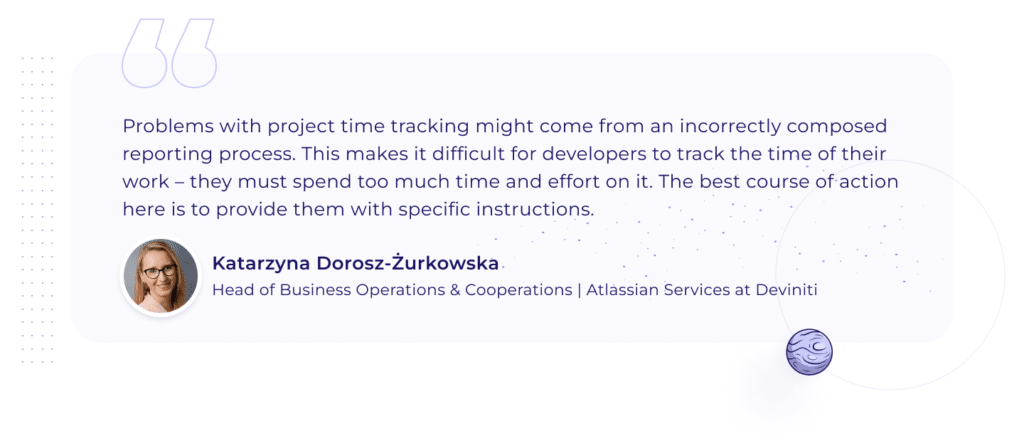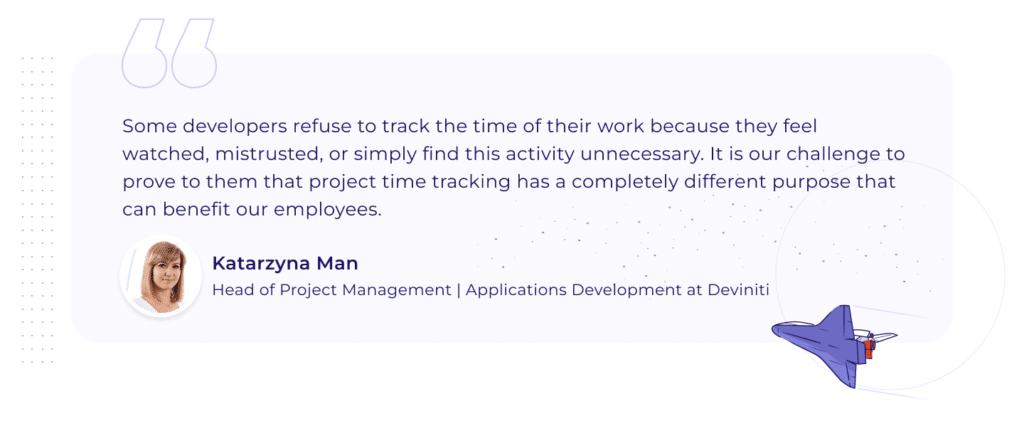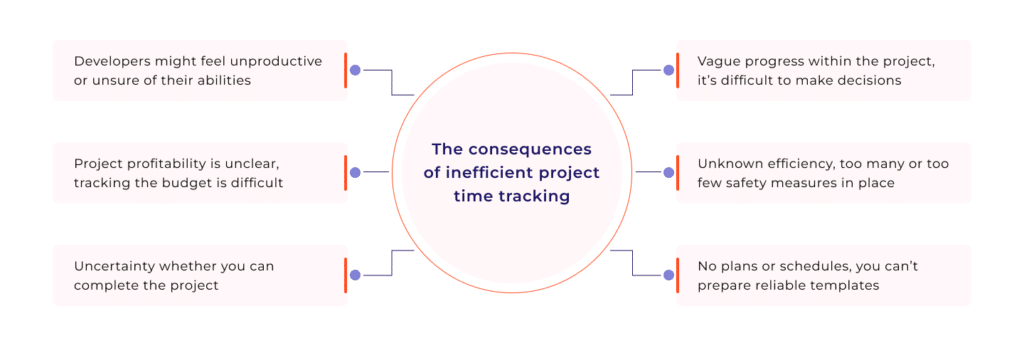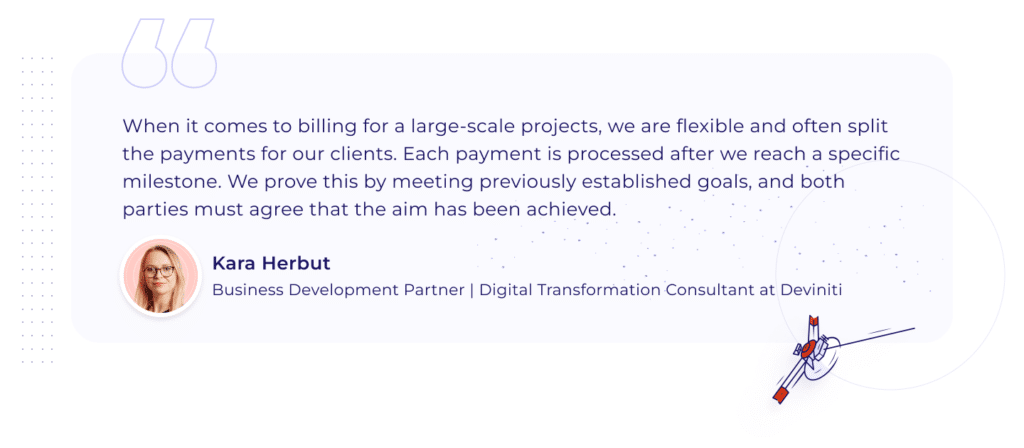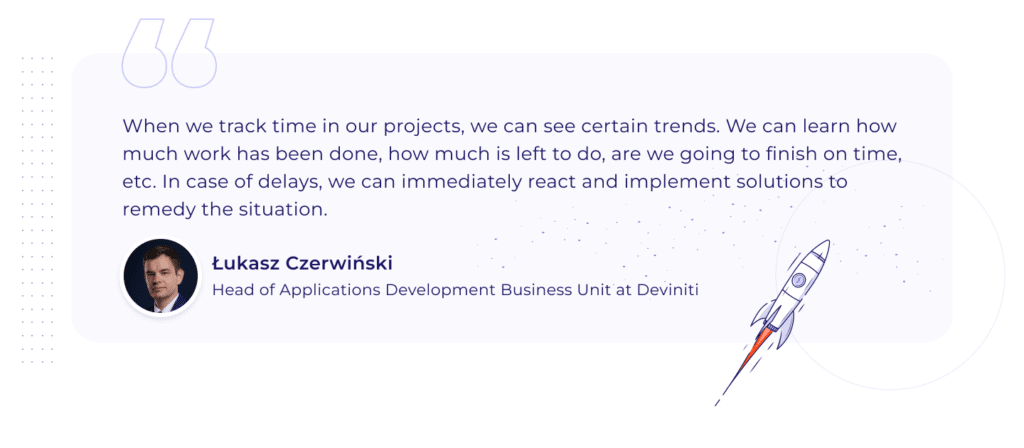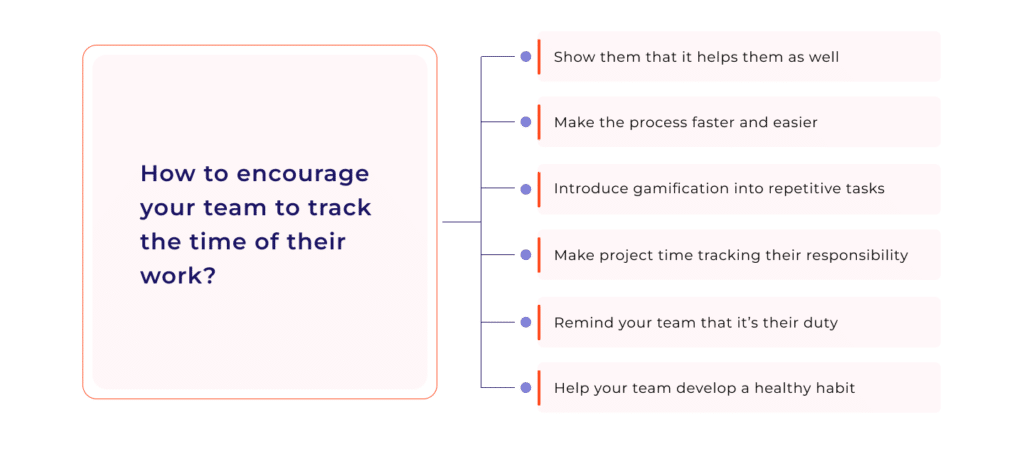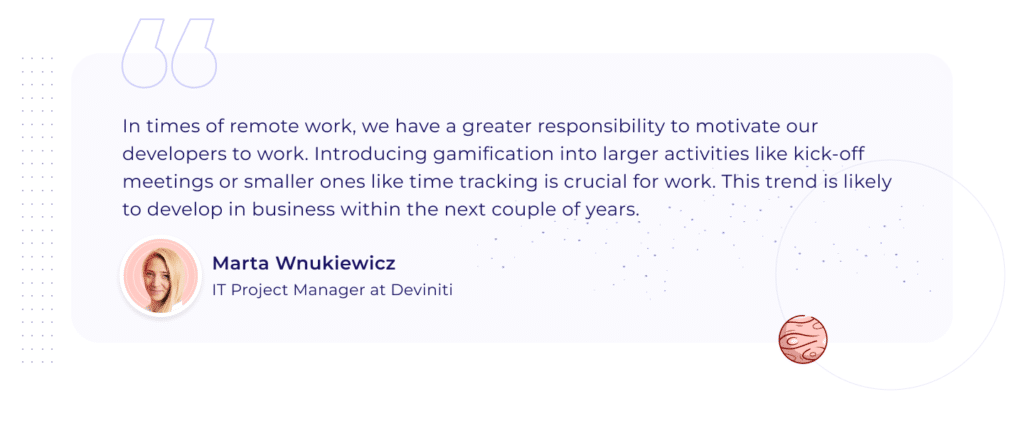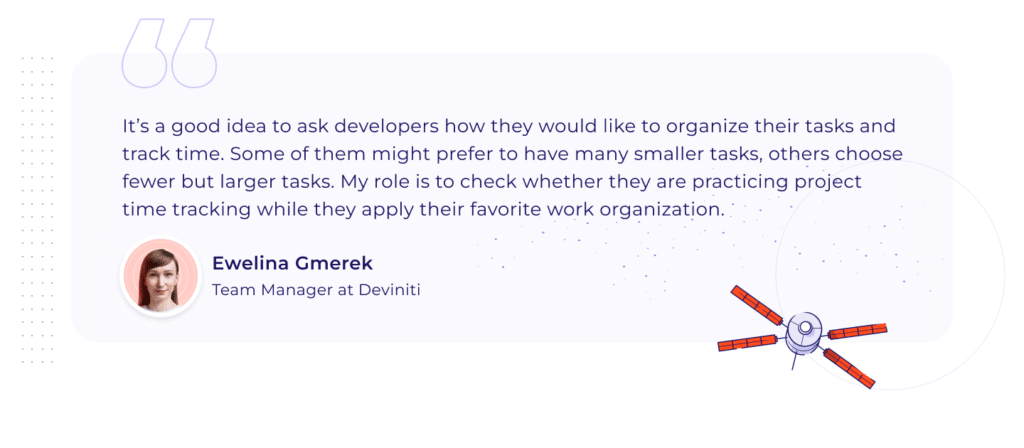6 ways to foster project time tracking in your team

Project time tracking is an essential part of software development project execution. It provides valuable insights into the current project stage as well as software development profitability and efficiency. It also allows you to prepare lessons learned and project templates for the future. Unfortunately, developers often have problems with tracking time, leading to severe consequences. In this article, we will investigate this problem and offer solutions to help you improve project time tracking within your team.
Where do problems with project time tracking come from?
Project time tracking can become a problem in any software development team. It is often observable among individual developers, but they aren’t always the ones to blame. Perhaps nobody has ever taught them how to track time. There might be some organizational issues in place as well. Before we even try to improve our project time tracking, we must reach the source of the problem.
Organizational issues with project time tracking
Project time tracking is too important to be left to chance. Yet, some software developers might be told to track time without any explanations. If this happens, we are talking about the absence of a project time tracking procedure. The developers can’t track time correctly if they don’t know how to do it.
Now, let’s consider another scenario. You have the proper procedure, even the best time tracking app. But your developers still aren’t tracking time properly. You discover that they keep postponing this task because it’s taking too long due to the lack of optimization. It’s only natural for your software developers to choose other, more effective activities. Zapier’s survey shows that 76% of employees spend 1-3 hours per day on data entry. Can you afford your employees to do so as well?
Even if you have an optimized project time tracking procedure, your developers still might neglect it. Sometimes the problem lies in the lack of awareness of project time tracking advantages. After all, it is useful for project planning, estimations for customers, and observing work distribution, e.g., between project management, analytical, and development tasks. People might be willing to do it when you show them the right perspective.
The last organizational issue relates to the project time estimation itself. The project planning part offers many time estimation techniques like MoSCoW prioritization or poker planning. It also involves sessions with Scrum Masters who question the estimation reasoning for better results. Nevertheless, you can still get incorrect estimations due to unforeseen events or mismatched expectations. This might lead to software developers altering their time tracking entries to match the plans rather than the actual time spent on the task.
Personal issues with project time tracking
The sad truth is that some developers are directly responsible for improper time tracking. For instance, they might consider it a form of employee monitoring. They don’t wish to be accountable for every minute of their work. ExpressVPN’s survey shows that 59% of employees feel anxiety knowing that their employer follows their online activity.
Other developers might fear possible accusations of inefficiency. They might have a feeling of missing a deadline, e.g., due to a lack of experience in a particular environment. Their unwillingness to cooperate comes from fear of failure. This fear might be fueled by statistics. ExpressVPN’s survey states that 46% of employers decided to end their cooperation with some employees due to monitoring their behavior.
You should remember that the developers’ work is sometimes difficult to track. Greg Smith observed in his article from 2014 that the developers’ worktime might be divided into highly efficient periods as well as incubation periods during which the developers deal with some minor tasks while their brains keep subconsciously processing solutions. The latter ones can mean time wasting for an inexperienced observer.
The last case is when developers don’t track time despite having every opportunity to do so. They will give you many reasons for this, e.g., lack of time or more important duties. The actual causes behind this are different priorities, improper work organization, or a lack of habit. When your developers reevaluate the work, they can establish a healthy software development time tracking routine.
The consequences of ineffective project time tracking
If you have any problems with project time tracking, you will face the consequences sooner or later. They will affect your current and future projects, your finances, employee efficiency, and even morale. If you doubt the importance of software development time tracking, learn the dreadful ABCs.
Ambition annihilation
Your developers play a vital role in the development process, so they need proper support. They are the ones doing project estimates, defining time frames, and willing to see the effects of their work. It is their main source of learning about strengths as well as weaknesses. Without time tracking, they can’t perform self-assessments to find areas of improvement.
If your developers can’t see the effect of their teamwork, they get a feeling of uncertainty about general productivity. Without proper data, they can’t participate in the planning stage, and don’t feel that the project is truly “theirs.” Consequently, their approach to work stems from a lack of ambition. Don’t expect a team with a “can-do” attitude if you don’t measure their efficiency.
Budgetary blunder
Project time tracking allows for successful project budget management. Otherwise, you don’t know how much time and money you have already spent. Even if you apply man-day estimations, you still get rough numbers, so you might be unaware of project profitability. Some projects might have been rejected after being proven unprofitable. But if you don’t know how much you spend, you might be losing money instead of making it.
If your budget decreases too fast, you can try to renegotiate the price with your client. Unfortunately, without specific numbers, there is no renegotiation option. When it comes to a fixed-price contract, you might carry out projects going over your dedicated project budget. With time and material contracts, your client might reject your invoice and stop trusting your company. Even if the decreasing project profitability isn’t your fault (altered project factors, new approach, state-of-the-art environment), you don’t have any reliable numbers to back up the price renegotiation.
Capacity crisis
Thanks to project time tracking you know how much time is devoted to specific tasks. You can plan resource distribution and project schedules to achieve predictable software delivery. If developers don’t track time, you can’t correctly assess if you have enough time and workforce to meet your deadlines. Even if you have a valid skill matrix in place, it’s still hard to decide whether you need the help of external developers.
To make things worse, you can’t create a project schedule. You must depend on incoming projects and often end up empty-handed. Note that taking upon larger projects becomes impossible without data-based planning. If this is your case, you won’t be very popular with clients.
Use our experience
Struggling with processes, tools, or problem in your
team? Find out how we can help you.
Development disarray
Practicing project time tracking gives your team a steady stream of tasks without risking any delays. When you don’t track time, your developers might suffer from incorrect task distribution: they will have too little or too much to do. This might lead to project delays, so your team will have to work overtime to ensure timely software delivery.
You also can’t be sure whether your developers are doing fine. Perhaps they would need support, especially when working on tasks outside their skill matrix. The last problem with software development time tracking here is a looming uncertainty about project milestones. You don’t know what your progress should be and when to implement remedial plans.
Efficiency emergency
Project time tracking greatly influences project efficiency. You can compare the estimated execution plan vs. actual performance using, e.g., burndown charts. You can also manage risk, set safety buffers (preferably once per project), discover trends, and optimize processes. Normally when a project buffer decreases, you can introduce technical improvements, resign from “nice to have” features to focus on “must-haves”, or create more automatic tests.
Without tracking time, you might need excessive safety buffers on the entire project in case of schedule shifts. Eventually, half of your work time will consist of project buffers, making the project unacceptable for your clients. What is more, you can’t optimize processes as you don’t know how they work. This will leave you with the same levels of efficiency for your upcoming projects.
Future fallacy
One of the main goals of project time tracking is understanding how to estimate time for a project. You can create an accurate project plan template or prepare lessons learned on possible problems and means to mitigate them. Your previous experience accumulated with software development time tracking makes planning fast and efficient. For instance, you have the right decisive factors to qualify tasks as small, medium, or large ones. Furthermore, you can confidently answer questions like “What is the estimated expected mean time for project completion?”
When your developers don’t track time, you end up without a valid project plan template. You can’t make any reasonable decisions on task duration. To make things worse, no current data means no lessons learned for your next sprint retrospective. Consequently, some problems might reappear in the following projects and cause damages that could have been avoided. Or, as the famous philosopher George Santanaya said: “Those who cannot remember the past are condemned to repeat it.”
6 ways to foster project time tracking in your team
Hopefully, you understand the necessity of tracking time by now. It’s easier said than done, so we have prepared 6 specific strategies that will encourage project time tracking in your team. Just remember that some methods might not always work for everyone. That’s why we also include possible risks that each strategy might entail. Experiment with them and see how it goes.
1. Emphasize benefits
Make your team aware that project time tracking helps them. When they are diligent with tracking time, they support establishing better plans or project buffers, accepting more projects, and increasing the company revenue. This, in turn, means that your developers can work on cooler projects and make more money. It’s a matter of improved software delivery resulting from monitoring time.
If your team doesn’t believe in the situation getting better, assure them that it won’t get worse. Thanks to project time tracking, you can create better plans based on lessons learned. Your developers will discover new things, strengthen their skills, and avoid work overload.
Remember that not all developers are aware of all these connections. You can organize a meeting, send a memo, or publish an internal tutorial. Most importantly, make sure that everyone understands the situation.
Risk
Some developers might not care about the overall company situation. They might not believe that tracking time will bring them anything good. Perhaps you can change their minds if you let other team members enjoy the said benefits first.
2. Project time tracking optimization
The more you practice project time tracking, the more you can optimize it. Inform your team that you accept suggestions on how to optimize tracking time. Collect ideas by organizing a brainstorming session or (virtual) suggestion box. You can even offer a prize for the best idea to incentivize your developers. They might come up with a solution saving much time on software development time tracking.
For instance, you can apply critical chain project management. This methodology helps you successfully allocate available resources to achieve your goals. One of the crucial advantages of critical chain project management is discovering new work streamlining options. Try it out and perhaps tracking time will become too easy for your team to be neglected.
Risk
Your developers might claim they don’t have time for project time tracking. So, they certainly won’t want to put extra effort into it. Nevertheless, try to emphasize the prize (an optimized process or the actual prize you are offering).
3. Apply gamification
Project time tracking can be fun! The answer to most repetitive tasks, especially during remote work, is gamification. An article by Review42 provides specific data on the topic: 90% of employees feel more productive with gamification elements at work while 72% get their inspiration to work harder. There are many gamification options, and some of them come directly from developers. We know of a team that collects money (even a dime works wonders!) for every failed task. Or rather, it is supposed to collect – people are so motivated that they haven’t gathered any money at all!
Such gamification examples are based on negative motivation, but let’s focus on the positive side. Take advantage of gamification software to make your work life easier. The effective gamification app app can turn any tedious task into a fun activity thanks to collecting points or badges and competing on scoreboards and leveling up. Brian Burke, the author of Gamify: How Gamification Motivates People to Do Extraordinary Things points out that these features are essential to game mechanics that encourage people to complete all kinds of tasks.
If you are into gamification incentive programs, offer something for collecting points. The prizes don’t have to be very valuable, just enough to introduce healthy competition among team members. If some of them get hooked, others might join thanks to the bandwagon effect.
Risk
Gamification is more popular with younger generations. Some people might complain about the unfair chances considering the tasks they have. They might also compete for winning instead of doing their tasks. Remind your developers that gamification is meant for fun and there is no need for ferocious rivalry.
4. Delegate responsibility
Sometimes the best thing to do is to do nothing. Don’t impose any specific method of project time tracking. Provide your developers only with the conditions and the deadline. Leave the rest to them while concentrating solely on the results. This might seem counterintuitive, but it often makes people feel more responsible for their tasks.
Your developers might come up with creative solutions to optimize the process or even gamification ideas. You don’t have to nag anyone about the task. It’s a simple transaction – you let them choose the method, and they give you the result. After a while, organize a meeting and summarize your observations. Perhaps you can gather all the optimization and gamification ideas and keep them for future use.
Risk
This strategy doesn’t work on people without a strong sense of responsibility. They might consider tracking time entirely useless. Others who usually need guidance might feel neglected. Make sure that your developers can manage such responsibility.
5. Remind about duties
It’s a simple strategy, but the effects can be surprising. Inform your employees that project time tracking is an obligation towards the company that results from their binding contract. It should be considered equally important as other tasks and carried out with the same diligence.
Such a blunt reminder can have two forms. The first one is offering your developers support. They might welcome this suggestion with open arms and tell you about their issues. Work together on a solution that will help them overcome obstacles in tracking time.
A harsher approach is an admonition. This method seems outdated, but some people claim that it’s the only thing that works for them. Remember that when you are admonishing your team, you must focus on the problem, not the person. Sometimes even a gentle reminder that you are unhappy with a certain situation will do the trick.
Risk
Some people might not have a strong sense of duty or simply be stubborn. While offering support might not upset anyone, an admonition surely can. Avoid it with sensitive people, and make sure you don’t criticize a specific person in public. This can lead to unnecessary tensions.
6. Create a habit
The saying “old habits die hard” is entirely true. Once people establish a habit, they always adhere to the same pattern. When you create a habit of tracking time within your developers, they will do it automatically, without questioning its validity. Charles Duhigg claims in his book The Power of Habit: Why We Do What We Do in Life and Business that habits consist of three parts: a trigger that initiates the habit, a routine activity that follows, and the reward expected at the end. If you want to establish a routine activity (project time tracking), think about the right trigger and reward.
You can either construct your habit loop or rely on solutions that will provide one for you. Dedicated gamification tools can be of great help here. Your team will get a trigger in the form of an application encouraging them to track time (the routine activity). Then your developers will get points as a reward. After some time, your team will develop the desired habit additionally strengthened by Trophy for Jira.
Risk
Creating a habit on your own will require you to constantly monitor your developers. When you teach your team to perform a task in a specific way, it will be very difficult to change it. Once formed, habits aren’t very flexible.
Track now, enjoy later
Project time tracking is an investment – when you start doing it, you will see profits very soon. Like every investment, it will need regular restructuring. But making your tasks more efficient, completing projects faster or generating more revenue, and improving company relationships is a worthy prize. And it all starts with a simple activity of your developers tracking time.
You can make software development time tracking go easily in your team. Just try out one of our strategies. Make sure you have considered all scenarios (including the risks provided) before applying a specific method. And remember that, as a team, you all are working towards a common goal. You all should share the benefits coming from it.

